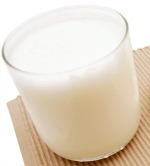Milk Allergy Overview

Milk allergy (aka dairy allergy) is a food allergy caused by the inability of a body to digest milk proteins. It is different from lactose intolerance, which deals with milk sugars. Lactose intolerance is NOT an allergic condition. Visit food intolerance section to read more.
Most milk allergies are outgrown by age of four at the latest. They only happens in 3% of children. Most allergies start during the first year of life, when the digestive and immune systems are still developing.
People with milk allergies are usually allergic to cow’s milk, as well as goat’s and buffalo’s milk – any milk protein.
Milk Allergy Symptoms
Milk allergy symptoms may start immediately upon the consumption of an allergen. They may also take several hours. Here is a list of possible milk allergy symptoms:
- Rash
- Hives
- Eczema
- Runny nose
- Swollen neck
- Blood in the stool
- Colic (see below for more information)
- Vomiting
- Diarrhea
- Constipation
- Wheezing
- Coughing
- Difficulty breathing
- Paleness
- Lack of energy
- Anaphylactic shock (collapse) (see below for more information)
Vomiting is one of the symptoms of milk allergy. However, babies can vomit when they have reflux or reflux disease GERD. Try eliminating dairy first. If your baby fusses at feedings or rejects breast in addition to spitting up and vomiting, it may be reflux, not the allergies. Consult a gastroenterologist.
Anaphylactic shock (collapse) is a very severe life-threatening allergic reaction. Symptoms develop very fast and medical assistance should be sought immediately. The condition is characterized by swollen face and throat, hives, abdominal pain, vomiting, diarrhea, low blood pressure.
Colic is another sign of milk allergies. Colic is described as a long period of inconsolable crying, usually happens at the same time of the day. Colic usually happens in the first three months of baby’s life. Then it goes away as suddenly as it starts.
Only recently doctors started associating colic with milk consumption. Cow’s milk is hard for the babies to digest, especially during the first three months of life. If a breastfeeding mother drinks cow’s milk, it gets into baby’s intestines with the breast milk and irritates them.
The connection between colic and mom's milk consumption is still widely debated.
You have a way to test it though. Try eliminating dairy from your diet. Allow
one-two weeks for milk protein to completely clear your and your baby’s
digestive systems. If symptoms of colic weaken, you know the answer. Visit Colic In Infants section to read more.
Prevention IS Better Than Treatment
Breastfeeding is the best way to prevent milk allergies. Breast milk has an ideal combination of sugars, easily digestible proteins and fats. Babies are never allergic to pure breast milk.
Most milk allergies are outgrown by the age of one. If you breastfeed exclusively at least till this age, you decrease the risk of milk allergies altogether.
In addition, if the allergies run in the family, you can also proactively avoid milk products while breastfeeding.
Cow’s milk is not recommended for babies under 12 months of age. If you don’t breastfeed until this age, your baby will need to take formula. Infant formula has intact milk or soy protein and can cause allergic reactions too.
Hypoallergenic formula is the only safe alternative to breast milk. Nutramigen (by Enfamil) was the formula of our choice. Read my story here.
The bottom line - breastfeed, avoid dairy products in your diet, avoid milk protein-based formula and your baby has the best chance of being allergy-free.
If your baby already shows signs of allergy try elimination diet –
eliminating all the dairy products from your and your baby’s diet. This is a
tough one. Milk products (whey, casein, lacto albumin, and caseinate) are found
in many foods and food supplements. Study the labels carefully. Some will surprise
you. Visit Allergy Testing section to read more.
What You Might Not Know
- cacao powder, gravies and sauces may contain dairy
- canned soups may have dairy ingredients
- most baked goods, breads contain dairy
- margarine contains dairy
- hot dogs, sausages, some desserts contain dairy
- even products labelled "non-dairy" may contain caseinate - a dairy derivative
- if you are giving your baby probiotics, make sure it is not dairy-based. The only milk free probiotics I found in my area was at Whole Foods - organic Raw Probiotics for Kids (by Garden of Life)
You can try re-introducing dairy products later. However, if the allergic symptoms were severe, avoid milk for a long time. Try re-introducing at the age of one, when many babies outgrow milk allergy.
During the elimination diet don’t be tempted to have even a drop of milk. For babies with severe reactions even a drop is too much.
Your baby’s pediatrician may also prescribe medications to help relieve allergy symptoms.
The most important thing you need to remember about milk allergies is that many are avoidable, if triggers are eliminated at least during the first year of you baby’s life. Breastfeed and enjoy your healthy baby!
There are many ways to show your love and devotion to your kids and to win their trust. Breastfeeding is the most natural one.
Yours,
Viktoriya
Back to top of Milk Allergy>Food Allergies>Breastfeeding Home










